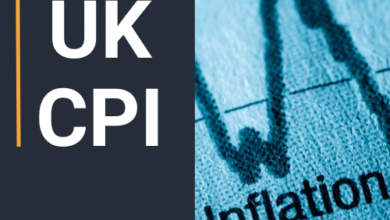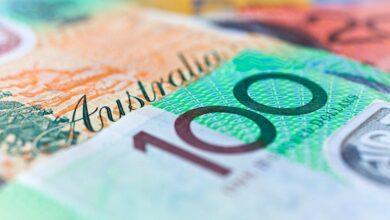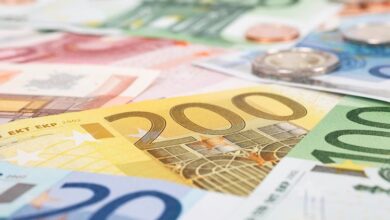Gold remains vulnerable near one-month low on bullish USD, Fed rate hike bets

- Gold price finds some support near the $1,900 mark, albeit fails to attract any buyers.
- A weaker risk tone benefits the safe-haven XAU/USD, though bullish USD caps gains.
- The Fed’s hawkish tone and elevated US bond yields continue to underpin the USD.
Gold price (XAU/USD) shows some resilience below the $1,900 mark during the Asian session on Wednesday, albeit struggles to register any meaningful recovery from over a one-month low touched the previous day. A generally weaker risk tone lends some support to the safe-haven precious metal, though the prevalent strong bullish sentiment surrounding the US Dollar (USD) acts as a headwind.
Data released from the United States (US) on Tuesday showed that the Conference Board’s Consumer Confidence Index fell to a four-month low in September. This fueled concerns that the consumers are feeling the pressure from the persistent high inflation and rising interest rates. Apart from this, worries about a real estate crisis in China – the world’s second-largest economy – continues to weigh on investors’ sentiment and benefits traditional safe-haven assets, including the Gold price.
Meanwhile, the USD Index (DXY), which tracks the Greenback against a basket of currencies, hits a fresh high since November 2022 and holds back bulls from placing aggressive bets around the XAU/USD. The Federal Reserve (Fed) last week struck a more hawkish tone, supporting prospects for further policy tightening. Moreover, the recent comments by several Fed officials reaffirm expectations for at least one more rate hike by the end of this year. This remains supportive of elevated US Treasury bond yields, which underpin the USD and caps the non-yielding Gold price.
Daily Digest Market Movers: Gold price struggles to attract buying amid bets for more Fed rate hikes
- A deterioration in the US consumer sentiment adds to market worries about a deeper economic downturn.
- China’s economic woes also weigh on investors’ sentiment and lend support to the safe-haven Gold price.
- The US Dollar climbs to a fresh 10-month peak and keeps a lid on any meaningful recovery for the metal.
- Bets for one more Fed rate hike in 2023 remain supportive of elevated US bond yields and underpin the USD.
- The benchmark 10-year US Treasury yield was last seen hovering near a 16-year high touched on Tuesday.
- The rate-sensitive two-year US Treasury yield holds above the 5.0% threshold, or its highest level since 2006.
- The recent hawkish remarks by Fed officials further reaffirms the higher-for-longer interest rates narrative.
- The fundamental backdrop warrants caution before placing aggressive bullish bets around the XAU/USD.
Technical Analysis: Gold price could slide to retest August monthly swing low
Gold price now awaits a sustained break and acceptance below the $1,900 mark before traders start positioning for an extension of the recent rejection slide from the very important 200-day Simple Moving Average (SMA). Given that oscillators on the daily chart are holding deep in the negative territory, the XAU/USD might then accelerate the slide towards testing the August monthly swing low, around the $1,885-1,884 region.
Fed FAQs
Monetary policy in the US is shaped by the Federal Reserve (Fed). The Fed has two mandates: to achieve price stability and foster full employment. Its primary tool to achieve these goals is by adjusting interest rates.
When prices are rising too quickly and inflation is above the Fed’s 2% target, it raises interest rates, increasing borrowing costs throughout the economy. This results in a stronger US Dollar (USD) as it makes the US a more attractive place for international investors to park their money.
When inflation falls below 2% or the Unemployment Rate is too high, the Fed may lower interest rates to encourage borrowing, which weighs on the Greenback.
The Federal Reserve (Fed) holds eight policy meetings a year, where the Federal Open Market Committee (FOMC) assesses economic conditions and makes monetary policy decisions.
The FOMC is attended by twelve Fed officials – the seven members of the Board of Governors, the president of the Federal Reserve Bank of New York, and four of the remaining eleven regional Reserve Bank presidents, who serve one-year terms on a rotating basis.
In extreme situations, the Federal Reserve may resort to a policy named Quantitative Easing (QE). QE is the process by which the Fed substantially increases the flow of credit in a stuck financial system.
It is a non-standard policy measure used during crises or when inflation is extremely low. It was the Fed’s weapon of choice during the Great Financial Crisis in 2008. It involves the Fed printing more Dollars and using them to buy high grade bonds from financial institutions. QE usually weakens the US Dollar.
Quantitative tightening (QT) is the reverse process of QE, whereby the Federal Reserve stops buying bonds from financial institutions and does not reinvest the principal from the bonds it holds maturing, to purchase new bonds. It is usually positive for the value of the US Dollar.
Get Best News and Web Services here







